2 March 2013
- Kayak trip on the Khwae Noi River in Central Thailand (Kanchanaburi area) from Thong Pha Phum until Sai Yok Yai as part of the Khwae Noi River Kayak Route.
- Technical data:
- We started off at the Mafai Khu Resort in Thong Pha Phum at 0815 Hr. There was a good current estimated at 5 to 6 Km/Hr and there were a few rapids along this track of the river. We arrived at the River Kwai Paradise (Raftel) in Sai Yok Yai around 1545 Hr.
- The weather was sunny and warm. Max. Temperature was 36 C and hardly any wind tangible in the Khwae Noi valley.
- Technical data of the trip was as follows: Total Distance: 58.9 Km; Moving Average: 8.5 Km/Hr; Overall Average: 7.7 Km/Hr; Maximum Speed: 13.1 Km/Hr; Moving time: 6 Hr 55 Min; Stopped Time: 41 Min; Total Time: 7 Hr 36 Min. We made no lunch stop along this track.
- Number of participants: 2 (Pat & Sean)
We had a slightly late departure from Ayutthaya due to Sean being caught up in Bangkok traffic after a meeting; however, after final loading and preparation, we were on our way by 16h00. The ride to Kanchanaburi was not uneventful, with Sean taking the time to test his new GoPro camera with which he hoped to capture some good footage of the trip. The road from Ayutthaya to Suphan Buri was new and we passed rai upon rai of beautiful rice fields emerald green in the afternoon sun. After that and on towards the town of U-Thong, the fields changed to corn and sugarcane, with many sugarcane trucks visible on the road, in addition there were many areas of roadwork’s which slowed progress. We got to Kanchanaburi just as the sun was setting over the now visible ranges of mountains in the area, and then headed up the long winding road to Thong Pha Phum that closely followed the course of the river we would paddle out of sight in the valley below. As we progressed it got darker and with no street lighting, the winding roads were quite hazardous; this was borne out by an accident between a car and motorcycle we came across around one of the bends. In addition, just short of our destination we encountered a strong rain storm that further slowed our progress, however this was fortunately brief and we arrived at our Thong Pha Phum around 20h00.
We had intended to launch our kayaks north of Thong Pha Phum in the area of Tha Khanun, below the Vajiralongkhorn Dam, and thus crossed the bridge over the river into the main town to look for accommodation close by. However, after spending a while driving around the dark, deserted streets, we were not able to find anything suitable. We then retraced back across the bridge to a resort we had noticed on the way into town, the Mafai Khu Resort where we were able to arrange rooms alongside the river for a decent price of Bht 800. We then had dinner and got our first glimpse of the river flowing in the moonlight, the flow looked promising. After dinner and talking about Japanese gold and treasure hunting over a beer, it was time to go to bed and prepare ourselves for the next day.
The next morning at day light, we got our first view of the river and the bank alongside; the location did not look too bad for launching the kayaks; although there was a steep drop to the river, there was a sandbag wall which we could walk down to launch. We prepared our kayaks and laid them on the bank above the river while we went to the restaurant terrace to have breakfast and coffee. While there we noticed the level of the water steadily rising, a clear indication that the dam was now releasing water, and a good sign as it meant that we would have a strong flow on the river. We hurriedly finished breakfast and headed down to our kayaks, slightly concerned that they might be washed away by the steadily rising river! However, we thankfully found them still there and prepared ourselves to launch on the first day of the trip.
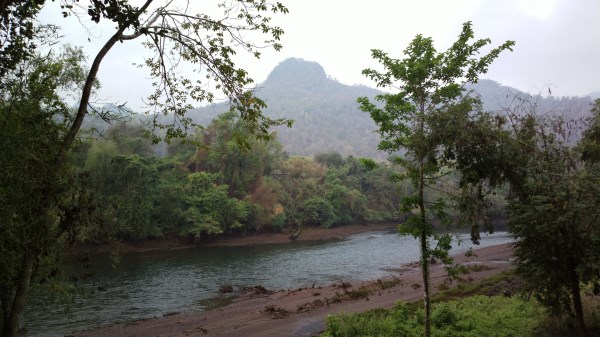
The launch was slightly delayed as Sean had problems setting up his GoPro camera which continued to freeze up, and after 15 minutes of trial, he decided to give it up and check the camera later in the evening. During the trip he continued to have problems and eventually settled on capturing all footage with his trusty Nokia 808 camera.

At 08h15 we hit the water. As mentioned, the water has been rising since 07h00, so Patrick assumed that the Vajiralongkhorn dam increases its water release in the early morning and reduces it, during the night. The river started to swell considerably and the current increased quite a bit. We shove off and paddled down the first one hundred meters when we encountered our first rapid. Water splashed against some rocks just under the water level and the water surface was filled with waves of white water. It was a bit of a shock to have the rapid that early in the trip and we were wandering how the rest of the nearly 60 Km track of the day would be! However we passed it with no problems, and as the day progressed our confidence grew as we negotiated each successive rapid, none of which could be classed higher that class 1 rapids, with small waves and clear passages on one of the sides. After that we found ourselves gliding gently down the emerald green river past river banks lined with dense, tall bamboo, through while the sun filtered through, which were in turn overshadowed by impressive mountain peaks on all sides, it was as if we had stepped into another world.
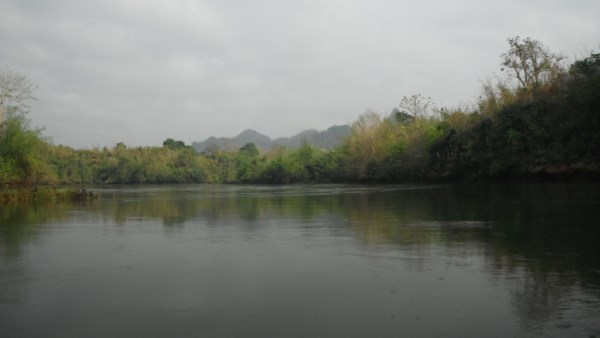
We were however, rudely awoken about an hour later, when we came across an even larger rapid than the first one we had negotiated; something closer to a Class 1+ rapid, that was to test us! The current was fast, water level high and we had only a passage on the right side, along a jagged sheer rock face. There was no escape zone in the straight vicinity and in case of capsizing it would be a harsh time for boat and paddler getting dragged over the rocks just below the surface. Sean went in first and took a line past the rapid on the right, using speed to avoid being swept against the rocks on the right bank; he went well and was soon through to the relative calm water beyond.
Patrick however got into a bit of trouble; Going with the flow, but heavier than Sean and thus laying deeper in the water, he got caught in an area of large turbulence. His kayak made a fast 180 degree turn, with his back facing the rapids and he felt water entering the boat from the rear left side when the swirl pulled the rear of the kayak. He quickly got the paddle out of the water and the boat did its job, stabilizing itself. This was close to capsize and he was not yet on the rapid. Now he had to leave the calm area and throw himself into the current again. He was just too far to the right to tackle the rapid the best way. There was not much choice and he pushed the kayak into the stream. The fast flow pushed him towards the rock wall. He tried with all his might to steer away, but had to avoid allowing the current to strike his left side, as this would definitely bring the kayak out of control. Seeing the rock wall fast nearing, he made a few quick paddle strokes to the right and tried to keep the bow more or less downstream. He succeeded in avoiding the cliff as smashing into it at 13 Km/Hr was no option. Pfff, finally he also made it back into normal water.
Meanwhile Sean was waiting further downstream, he had tried to slow up to wait for Patrick, however any attempt to turn around the kayak bought it side on to the flow which risked being turned over. This incident and the risk of someone getting rolled and separated from their kayak, was something that would be discussed when the day was reviewed over a Beer Singh later that evening.
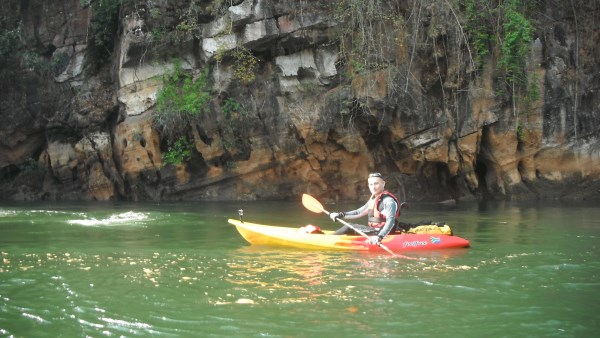
After the fun of the rapid, the trip resumed the quiet calm of normality, we continued downstream and near the first bridge we observed a small pagoda on top of a rock on the left bank. Wat Prang Kasi, is situated at the foot of the rock on the east side and the bridge must be leading to the monastery. In this area, a bit of a distance from the river's left bank, were the locations of three former POW working camps for the Thailand-Burma Railway. The camps were called: Prang Kasi Kilo, occupied by Dutch POW; Prang Kasi, a camp east of the now defunct railway station and Prang Kasi South where British and Australians of Dunlop's Force were situated in a camp along the river, south of the railway station.
We came across the first raft hotel at around 10h30; it was the I Ya Resort, situated close to a monastery on the left bank. A half hour later we paddled under the suspension bridge of the Green World Spring Hotel Resort & Golf Club, a surreal experience after being immersed in the natural wonder upstream the last 2 hours. The 18-hole course in a bend of the river featured some holes across the river; so we not only had to duck for the suspension bridge but also for the flying golf balls. Just after the bend another rapid demanded our attention, we were quickly finding out that paddling the Khwae Noi River was not quite the same as the other rivers we had paddled before. We needed to "read" the river at all times, to avoid surprises. Whirls, boilers and rapids lived in every bend of the river.
By this time it was late morning and we sought out a place to stop and get out of our kayaks to stretch our limbs and replenish our strength with water and energy bars. As we paddled around one corner we saw a set of rocks in the middle of the stream with a nice still pool of water and a small waterfall on the inside near the bank. As we paddles towards it we saw a snake hurriedly leave the rocks and swim across in front of us to the riverbank further up, this gave this small oasis its name of ‘Snake Cove’! We took time to rest under the shade of the trees enjoying the beautiful river spot while we ate our snacks. After a while we hit the water again and soon dived under the bridge below Hin Dat, the latter village is known for its hot mineral springs, although geographically the springs are at Kui Mang. The story goes that the springs were accidentally discovered by Japanese soldiers who were supervising the construction of the Death Railway during World War II.

At the time of the earthquake and the deadly tsunami in the Indian Ocean that followed on 26 December 2004, the temperatures of the hot springs along Three Pagodas Faults abruptly increased. The temperature at the Hin Dat thermal spring went up and the water became milky at approximately 8 a.m. in the morning. Most of the Kanchanaburi hot springs are commonly located along the lines of Three Pagodas Fault and lower number of hot springs along the lines of Sri Sawat Fault. These two major active faults run from Myanmar to the middle of the Chao Phraya basin, however new evidence suggests that the active Three Pagoda Fault could extend much farther south to the Gulf of Thailand.
After the bridge and an east bend in the river we passed the Nakakiri Resort & Spa, which indicated the end of the first track. Initially we planned to do this trip in eight days, but to save some of Sean's holidays; we decided to do the full route in four ‘sporty’ days!
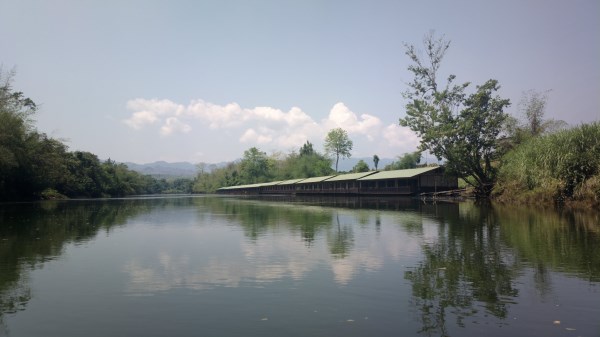
We paddled through Lin Thin area, where a working camp was established by the Japanese for Dutch prisoners of war; 2830 Dutchmen perished along the Railway of Death. All were buried at the three cemeteries; Don Rak and Chung Kai in Kanchanaburi, and Thanbyuzayat in Burma.
On the way to Sai Yok Yai, known before as Kin Sai Yok (a POW camp existed here) we started to notice more and more floating hotels, as well as houses along the river banks. The scenery was also changing as the surrounding hills moved closer to the river as the valley narrowed down. At about 14h30, we passed a very big raft hotel, The For Rest Hotel on a long bend in the river, we saw the guest relaxing in the afternoon sun and started to also get into the ‘relax mode’; we had made good progress for the day with the strong flow and were now into the last hour of the day’s journey, however this premature lowering of the guard nearly proved costly!
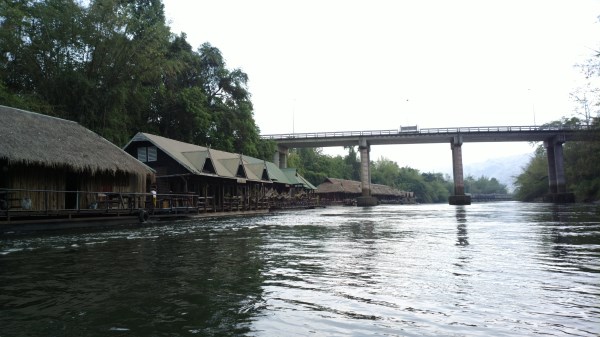
Three kilometres before our arrival point of the day and after a slight bend, the river widened featuring an island mid-stream, Sean took the flow to the left, through the clear water he could see the pebble bank below, and it was not very deep. Patrick however was busy taking pictures of the beautiful scenery and did not see the danger lurking ahead; suddenly an invisible hand dragged his kayak onto the pebble bank on the right of the island which was unfortunately shallower than the one Sean had negotiated. He tried to battle the swift current, but to no avail; he was stuck hard on the bank. He heard his rudder grinding the pebbles and, fearing it would break off; he reversed the kayak into the current rounding the pebble bank. The current then pushed him towards some fallen trees which he managed to avoid and finally came back in the main current. At this point a valuable lesson was learned, "read" the water at all time.
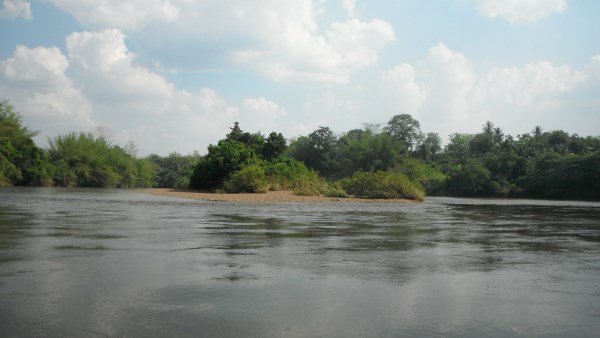
As we neared the River Kwai Paradise, another raft hotel and our lodging for the night, we were engrossed in a discussion as to how to land our kayaks at the destination as the current was strong and getting onto the raft would probably not be a piece of cake. While we were talking, Sean suddenly caught a glimpse of some boiling water ahead and some big exposed boulders; "Rocks!” he shouted, “head to the right!" with which he frantically paddled to the right to clear the obstacle ahead. Patrick however hesitated for a second and stopped paddling while he tried to catch what Sean had just said, it was then that he noticed the big rock formation just under the surface. His boat started to drift left as it got sucked towards the rocks and going right was not an option anymore. He paddled hard to the left to avoid the obstruction, but as he was now positioned perpendicular to the river, the current pinned him against a jutting rock. He was stranded, sitting high and dry on a little island; dry was rather an illusion as now his kayak started to fill up and was near capsizing as more and more water piled up behind it; it was a very precarious situation. He looked downriver at Sean and realized he had to quickly get out of this situation. He pushed the kayak off the rock with his hand and tried as much as possible to steer the bow in the downstream direction but then hit another rock, which again he pushed off by hand and finally fell back in an eddy, another close call, but back to normal, or so we thought. The river was not finished playing with us for the day!
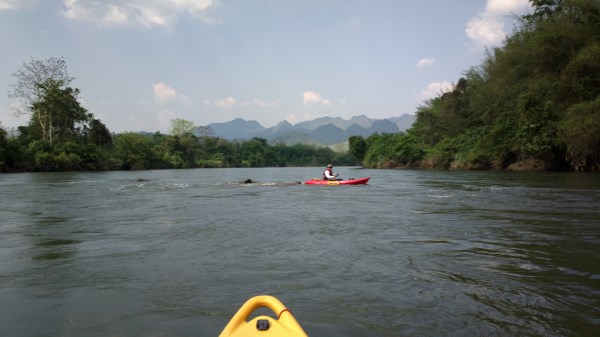
A short distance later we saw the bridge and the River Kwai Paradise raftel and started to manoeuvre to come alongside one of the rafts. At this point however due to a combination of the river bend, bridge columns and water depth, the river had speeded up and our landing was going to be hairy! Decisions had to be made in seconds as once swept past, it would be difficult to come back. Sean was ahead and took the decision to grab onto the first raft available in order to assess the situation and manoeuvre from there, the raft he had held onto however had no way to get out.
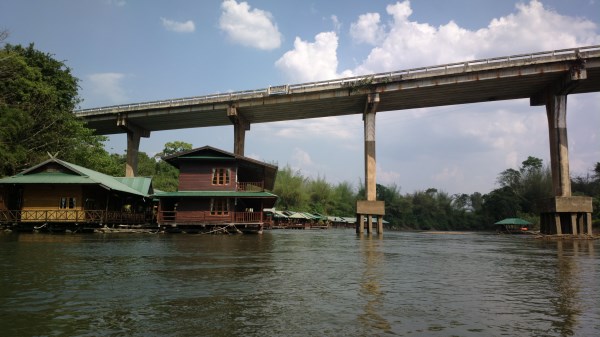
Meanwhile, Patrick focussed on the restaurant raft as he saw a ladder hanging in the water. He passed it then turned his kayak against the current so that it became parallel with the raft and then paddled like crazy against the current to get back to the position of the ladder. He reached the ladder with his last breath and roped the kayak to it. However, now the most difficult part of the action had arrived, getting out of the boat and onto the ladder. He put his foot on the lowest rung and at the moment he left the kayak, the rung broke and the kayak shot away in the current, but luckily the rope held! However he was now hanging onto the ladder, legs in the water. He put his foot on the second rung, but this also broke! The adrenaline now swept through his body as he started to glide away under the floats of the raft, which would be an all but comfortable position. In a last effort he succeeded to grab the only rung left and pulled himself on board the raft. As his kayak was dangling in the current and he did not trust the rope and knot tying it to the raft, he tried to pull it onto the raft. However, nearing the vertical, the seat and the luggage at the rear took the brunt of the current and he had to release the kayak. The kayak snapped down and turned upside down in the current, but luckily the rope held again. In a second attempt he finally managed to lift the kayak on board of the raft.
During all this time, Sean was still hanging on the hand rail upstream, with problems of his own as the force of the flow behind was forcing water up over the back of his kayak and threatened to engulf it at any minute. He could see what was going on with Patrick ahead but was powerless to help. Finally, after Patrick had managed to land his kayak, he noticed a second ladder further down the raft and called Sean to paddle down and get out there. Sean released the grip on his raft and paddled down to the Restaurant raft, again having to turn into the current and paddle furiously against it to come alongside the raft. He handed Patrick his rope to tie off his kayak and then managed to climb out using the ladder, which thankfully in this case held! The two of them then managed to pull the kayak on board against the strong flow. Finally we had 2 paddlers and kayaks safely on top of the raft, an exercise that took over 10 minutes of effort! By this time it was now 15h45 and Day 1 of the trip was finally complete.
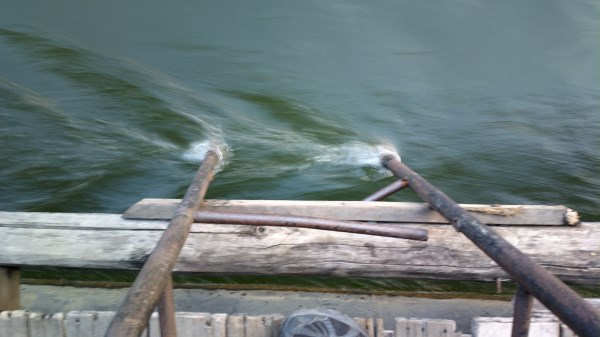
Once we got hold of our senses we looked around and found the place to be deserted, however, after walking around, we finally found somebody from the staff who led us to our room’s at the southernmost raft of the complex. Again, our ordeal was not over; as we now had to carry our kayaks and gear in relays all the way from the Restaurant raft to our lodgings, a good 100 m away! When this was complete, we were finally able to relax, and spend some time reorganising and consolidating for the next day. Then after showering off the days grime and relaxing and taking in the sunset on the terrace of our raft, at 18h00 we headed for the dining hall for a well earned beer, where we sat and recapped the events of the day. The couple of near missed made us aware of the need for contingency plans in the event of any further incidents. It was agreed that should any one of use capsize or get separated from our kayak, the plan would be as follows:
1. The other kayaker would paddle to go and secure the loose kayak leaving the capsized kayaker to drift safely down the stream with the aid of their life jacket.
2. He would secure the 2nd kayak to his kayak then paddle to regain the capsized kayaker who would then hold onto his kayak.
3. The mounted kayaker would then attempt to find a same beaching location and paddle them there to re-organise.
Thankfully this action was not required at any stage during the trip, but it was good to know we had a plan for the eventuality.
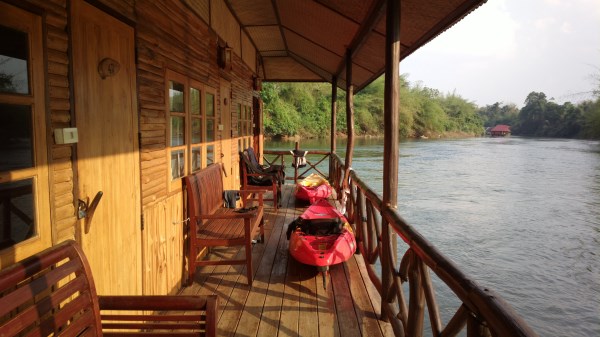
While we had been engrossed in our discussion, buses arrived and the raftel slowly filled up with a big group of package tourists, the Buffet was then opened and we went for diner. After discussing the activity of the next day we returned to our rooms for the night; 60 kilometers done, surprisingly not feeling tired physically, but more mentally as we wondered what secrets the river had in store for us the next day.